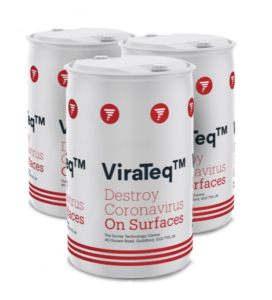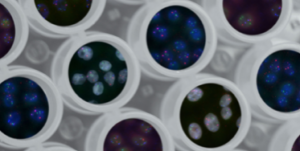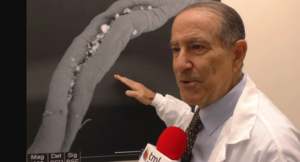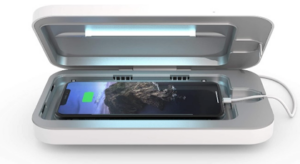An innovative response to COVID-19

The COVID-19 pandemic is having devastating consequences on human health and the global economy. The disruption to individuals and businesses around the globe has been immense, and we undoubtedly face a long and challenging road back to recovery. However, what we have witnessed in response to this virus is an astonishing and unparalleled effort from the global scientific community to conduct research focused towards understanding, controlling and preventing the spread of COVID-19. Media is awash with news of vaccines, improved testing technologies and efficacious drug treatments, but this is only part of the story. There is significant effort being dedicated to other innovations that can improve our everyday lives, safeguard our health and wellness, and better prepare us against any future viral outbreaks. The chemical science and material science communities in particular have been highly active in this regard. Too many to cover in one article, a small selection of key innovation themes emerging from the COVID-19 pandemic are summarised here, along with illustrative examples of new products and technologies being developed within each category.
Biocidal paints, coatings, and surfaces
The demonstration that COVID-19 could not only be transferred between people, but also between exposed surfaces and individuals has intensified research into anti-microbial materials that can rapidly and effectively eliminate viruses. A recent study published in the New England Journal of Medicine found that the SARS-CoV-2 virus (responsible for COVID-19) survives for up to 3 days on surfaces such as plastic and stainless steel. Therefore, decontamination of commonly used surfaces such as door handles and countertops is important in reducing transmission rates, particularly in public spaces such as hospitals and schools.
UK-based firm Smart separations have developed ViraTeq, a coating containing synthetic antimicrobial peptides which burst the outer lipid membrane of the SARS-CoV-2 virus, rendering it inactive. Multiple applications are being considered including sprays, for use on touchscreens and lift buttons etc., and antiviral ‘stickers’ for application on commonly used surfaces such as ATMs.

Whilst there are clear benefits in terms of reduced viral transmission, the increased use of chemicals in the home and work environment may cause concern for some. To address this, efforts are also being made to develop more natural solutions that offer the same level of anti-viral protection as chemical alternatives. For example, Welsh company Pennotec, working in conjunction with Bangor University’s BioComposites Centre are developing an anti-viral coating based on modified chitosan, a natural compound found in lobster and crab shells. Their work received funding from the heavily subscribed UK Government scheme ‘Business-led Innovation in response to global disruption’. Ultimately the company hope to use their coating on PPE and medical devices, although a range of other applications are also being considered.
Mechanical approaches also represent a promising alternative to chemical antibiotics. Like Pennotec, Keronite (US) also received an InnovateUK grant to continue development of their antiviral surface coatings. The company utilise an advanced coating technology called plasma electrolytic oxidation (PEO). This forms a ceramic-like multi-layered coating on light metals used in healthcare and other applications where antimicrobial properties are required. The top layer is highly porous and, when combined with TiO2, acts as a potent photocatalyst to aid the destruction of airborne pathogens, such as those that cause Covid-19.

Regardless of whether they are natural, chemical or mechanical in nature, antimicrobial surface technologies are likely to be commonplace in the near future. Whilst there are still some hurdles to overcome in terms of proving longer term performance / durability and securing regulatory approval, this is more than offset by the peace of mind they bring to consumers in the wake of the coronavirus pandemic. Thus expect this to be an area of considerable growth, primarily driven by adoption in shared spaces such as hospitals, schools and workspaces.
Antiviral and antimicrobial textiles
Developing fabrics with anti-viral properties for personal protective clothing is another key area of innovation spurred on by the COVID-19 pandemic. PPE such as gowns and facemasks not only prevent spread of the disease, but provide essential protection for front line staff and essential workers. As a result, many key players in the textile industry prioritised the development and manufacture of functional fabrics in 2020, recognising the critical role they could play in tackling this disease.
Carrington Textiles developed a new silver-based ‘Antiviral and Antibacterial Finish’ for fabrics which captures and deactivates the virus before it can pass through the ‘pores’ of the fabric. When applied to scrub suit poly-cotton fabric, it deactivated over 99% of enveloped viruses in two hours. Even after 50 washes at 60 degrees, 98% of viruses were deactivated. Similarly, PolyCAT – a British science-technology firm – recently refocused their efforts in response to the current Covid-19 crisis and developed a glove impregnated with active silver nanoparticles to provide a re-usable and effective barrier to the spread of viruses via touch and contact surfaces.

Other companies are looking for new approaches to develop anti-viral textiles. For example, Israeli start-up Sonovia developed an ultrasound-based technology that uses a process called cavitation to force reagents into the fabric at high velocity. In this way, individual textile fibres can be coated with antiviral chemicals such as a zinc oxide, without the use of chemical binders. The company says its proprietary zinc-coating remains effective after 55 washes.

Existing technologies, novel applications
Many organisations are identifying new applications for their existing technologies to support the battle against COVID-19. For instance, Henkel conductive inks were used in the development of a smart health patch that allows remote, wireless monitoring of patient vital functions and is being tested for monitoring COVID-19 patients. A ‘sensor dot’ located in the centre of the patch is placed on the patient’s chest and collects vital signs which it sends to the cloud wirelessly. Using such technologies, patient follow up at home can be improved, reducing the burden on health services.

In another example, Unilever research has demonstrated that CPC (cetylpyridinium chloride) technology – already widely used in the dental industry – is effective in reducing the viral load of SARS-CoV-2. Thirty seconds of rinsing with a CPC-containing mouthwash was sufficient to reduce viral load by 99.9%. These results have been widely shared so consumers can consider introducing a CPC-based mouthwash into their daily routine.
It has been known for a long time that UV-light is effective in deactivating airborne viruses by destroying viral DNA. A recent study published in Nature suggests that low dose far-UVC exposure can potentially safely provide a major reduction in ambient levels of airborne coronaviruses (99.9% within ~25 minutes) in occupied public locations. Building on this, new portable, at-home applications for this technology are emerging. We are now being told that top of our Christmas list should be portable sterilizer boxes which claim to offer effective anti-bacterial protection for items including phones, credit cards and keys.

Summary
The immense cross-sector, collaborative response to the COVID-19 pandemic has resulted in the emergence of many effective and innovative technologies that will both aid our recovery, and enable us to more effectively respond to future outbreaks and pandemics. Some sources of innovation are unexpected, but this pandemic has forced us to look at technologies in new ways and assess how they can be adapted and used to get both society and the economy back on it’s feet. Learning to embrace good ideas, regardless of source, and being adaptable to change will be important attributes of successful companies during this period of recovery.
At Strategic Allies Ltd, we make it our mission to uncover real innovation opportunities for our clients. As we move forward in our recovery from COVID, we will continue to work with them to help build collaborative ecosystems, support new technology development, and uncover new applications for existing technologies.
If you would like to learn more about how we can help your business, please get in touch with us on 01442 800565 or contact John at Strategic Allies Ltd on 07974 403530, or via john@strategicallies.co.uk
Author – Helen Peachey – Strategic Allies Ltd